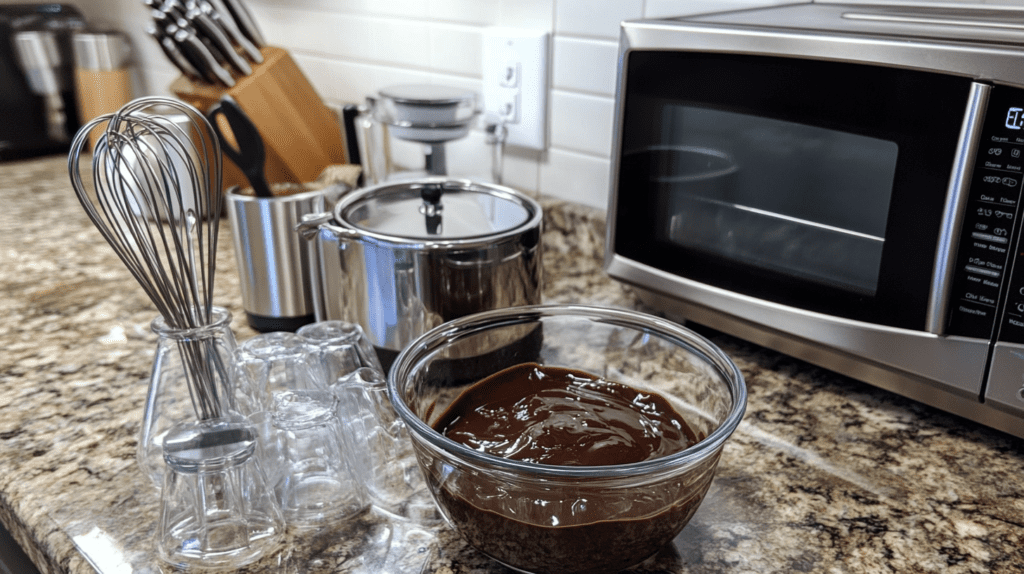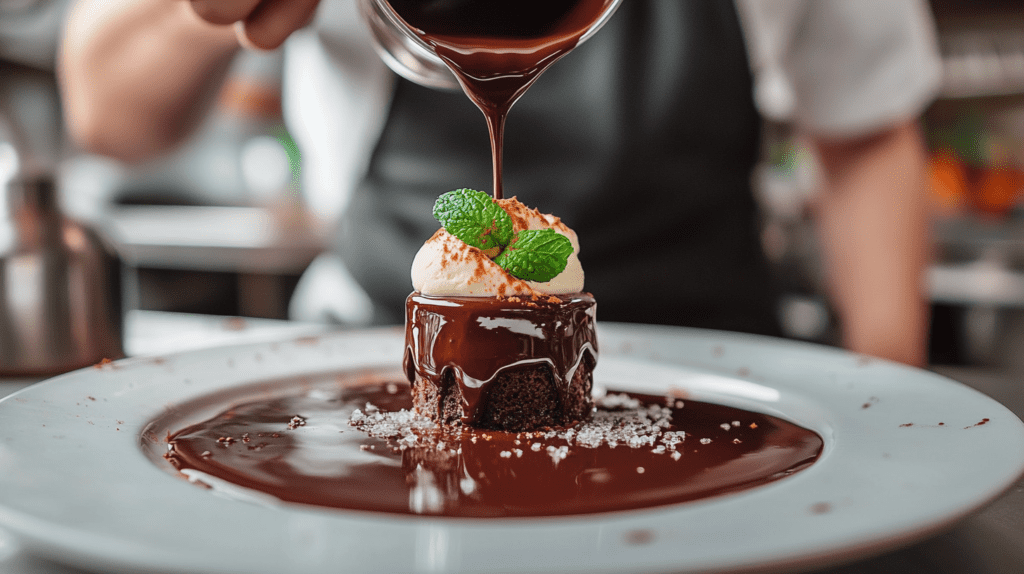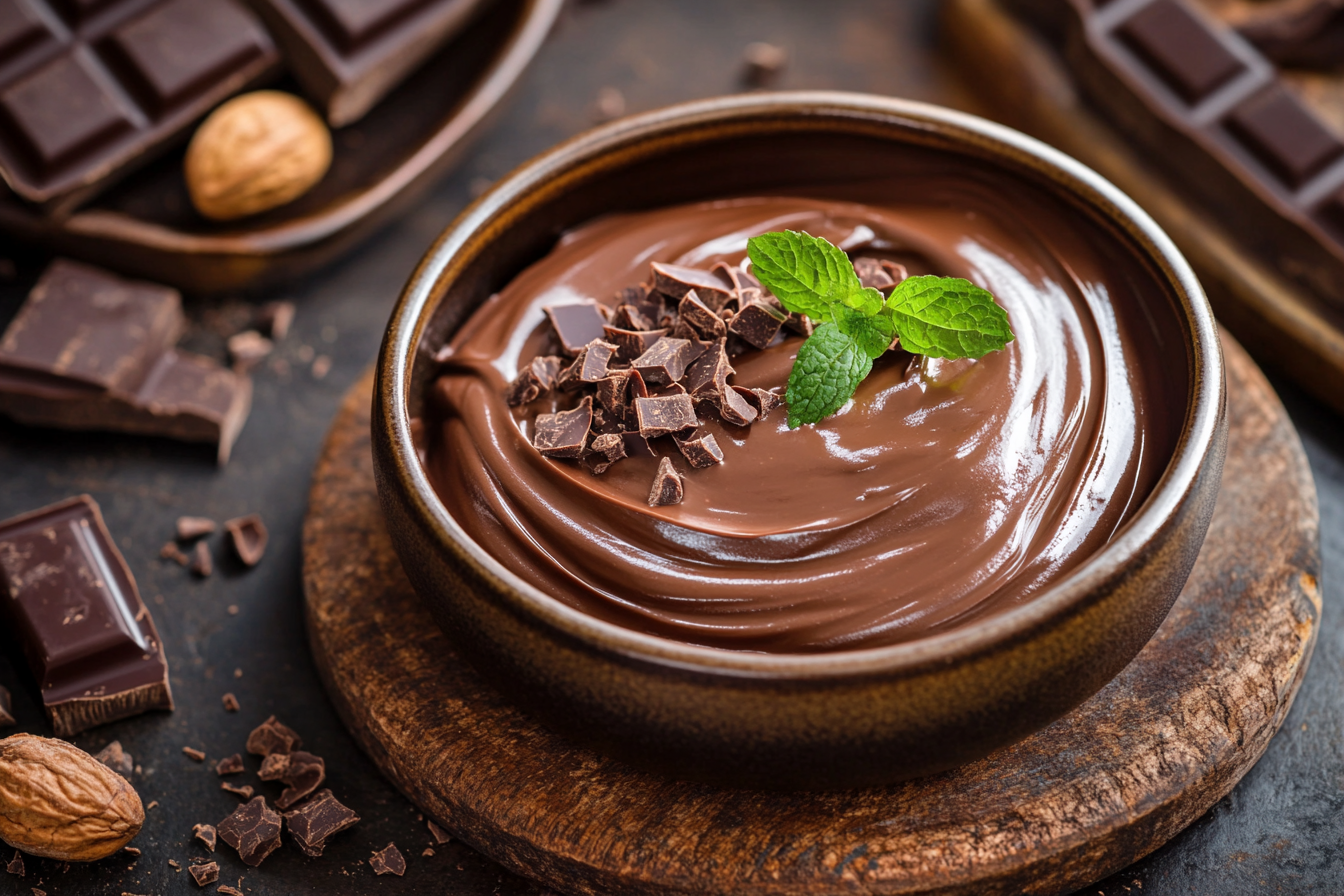How to Decrystallize Chocolate Sauce? Crystallized chocolate sauce can be a real downer, but don’t worry! In this guide, we’ll dive into the causes of crystallization, the science behind it, and how you can fix it effortlessly. With clear instructions, helpful tips, and a sprinkle of kitchen know-how, you’ll restore your chocolate sauce to its velvety, rich texture in no time.
Understanding the Problem of Crystallized Chocolate Sauce
What Is Chocolate Sauce Crystallization?
Chocolate sauce crystallization happens when the sugar in the sauce reforms into large crystals, creating an undesirable grainy texture. While it doesn’t render the sauce inedible, it does make it less appealing for drizzling over desserts or incorporating into recipes.
This crystallization typically stems from sugar’s natural properties, especially when external factors like temperature and moisture come into play. And let’s face it, who wants gritty chocolate sauce on their ice cream?
Why Does Crystallization Occur?
Crystallization can occur for several reasons, including:
- Temperature Fluctuations: When the sauce is exposed to extreme heat or cold, the sugar molecules can bond more readily, forming crystals.
- Improper Mixing: Inconsistent stirring or insufficient blending can allow sugar to cluster.
- Moisture Levels: Introducing too much or too little water can disrupt the balance of the ingredients, triggering crystallization.
These factors combine to make crystallization a common problem. Understanding why it happens is the first step to preventing it.
Impact of Crystallization on Texture and Flavor
While crystallization primarily affects texture, it can also dull the sauce’s flavor. Instead of a smooth, silky consistency, you end up with something closer to gritty fudge. Thankfully, with the right techniques, you can quickly bring back the glossy, rich quality your chocolate sauce deserves.
Science Behind Chocolate Sauce Crystallization
What Causes Crystallization in Chocolate Sauce?
To tackle crystallization, it’s crucial to understand the role of sugar’s natural chemistry. Sugar crystals form when individual molecules of sucrose bind together into larger, structured clusters. But why does this happen? Here are some common culprits:
- Temperature Swings: Repeated heating and cooling can destabilize the sugar solution, encouraging crystallization.
- Contaminants: Introducing foreign particles like dust or leftover food residue can provide nucleation points, acting as seeds for sugar crystals.
- Incorrect Ratios of Ingredients: The balance of sugar, liquid, and fats in your recipe plays a significant role. Deviating from the ideal proportion makes crystallization more likely.
Each of these factors alters the delicate balance needed to maintain a stable, smooth sauce.
How Does Sugar Chemistry Affect Chocolate Sauce?
At the heart of crystallization lies sugar chemistry. Sugar molecules are naturally prone to reordering themselves into crystals under certain conditions. Here’s how:
- Water and Sugar Interactions: Water dissolves sugar, creating a saturated solution. However, when water evaporates due to heat, the sugar has less liquid to keep it dissolved.
- Supersaturation: If there’s too much sugar for the liquid to handle, the solution becomes supersaturated, a perfect storm for crystallization.
- Agitation: Excessive stirring or movement can disrupt the sauce’s molecular structure, giving sugar molecules a chance to clump.
Understanding these chemical interactions can help you tweak your approach to keep your chocolate sauce smooth and luscious.
Preventing Crystallization
Best Practices to Avoid Chocolate Sauce Crystallization
An ounce of prevention is worth a pound of cure! Keeping chocolate sauce from crystallizing starts with smart kitchen habits. Here’s what you can do:
- Store Properly: Always use airtight containers to prevent exposure to moisture and air. Store your chocolate sauce at room temperature or in a slightly cool spot to avoid temperature extremes.
- Maintain Consistent Temperature: Avoid drastic heating or cooling cycles. If you’re reheating, use gentle methods like a double boiler rather than direct heat.
- Clean Tools Matter: Ensure all utensils and storage containers are squeaky clean. Any leftover food particles or oils can act as triggers for crystallization.
By controlling environmental factors and being mindful of storage, you can significantly reduce the likelihood of your sauce crystallizing.
Essential Ingredients and Additives to Prevent Crystallization
Certain ingredients can be lifesavers when it comes to stabilizing chocolate sauce. Let’s explore:
- Corn Syrup or Glucose: These invert sugars prevent sucrose molecules from bonding together, helping to keep your sauce smooth.
- Lecithin: Acting as an emulsifier, lecithin stabilizes the mixture, keeping water and fats from separating.
- Cream or Butter: Fats like cream and butter provide a rich texture and coat sugar molecules, making it harder for them to crystallize.
Incorporating these ingredients into your recipe doesn’t just enhance stability—it elevates the flavor and texture of your chocolate sauce.
Step-by-Step Guide to Decrystallizing Chocolate Sauce

Tools and Equipment You’ll Need
Before you begin decrystallizing your chocolate sauce, gather the right tools for the job. Proper preparation will save you time and ensure a smoother process. Here’s what you’ll need:
- Double Boiler or Microwave: For gentle, controlled heating.
- Heat-Resistant Bowl: Glass or stainless steel works best.
- Whisk or Silicone Spatula: For stirring and achieving a smooth consistency.
- Liquid Additives: Water, milk, or cream to adjust the texture.
Having these tools at hand ensures that you can efficiently restore your chocolate sauce to its perfect state.
Methods for Decrystallizing Chocolate Sauce
Using Gentle Heat
Gentle heating is one of the most effective ways to dissolve sugar crystals without burning the sauce.
- Double Boiler Method:
- Fill the bottom pot of the double boiler with water and bring it to a simmer.
- Place the chocolate sauce in the top bowl and gently heat it while stirring continuously.
- Ensure the water in the lower pot doesn’t touch the upper bowl to prevent scorching.
- Microwave Method:
- Transfer the sauce to a microwave-safe bowl.
- Heat in short 10-15 second intervals, stirring between each burst.
- Stop as soon as the sauce begins to liquefy and the crystals dissolve.
Adding Liquid to Rebalance Sugar
Sometimes, reintroducing moisture can help dissolve crystallized sugar and bring the sauce back to life.
- Select the Right Liquid:
- Use water, milk, or cream, depending on the sauce’s original recipe.
- Avoid overdoing it—start with 1–2 teaspoons.
- Mix Thoroughly:
- Heat the sauce gently and stir in the liquid gradually.
- Continue stirring until the crystals dissolve completely.
Reheating and Stirring Techniques
Reheating is a delicate process that requires constant attention.
- Place the sauce over low heat in a pan.
- Stir gently but consistently to prevent the sauce from sticking or burning.
- Watch closely—once the sauce becomes smooth and glossy, remove it from the heat immediately.
By following these methods, you can easily reverse crystallization and restore your sauce’s original texture and shine.
Troubleshooting and Common Mistakes
Common Mistakes to Avoid When Decrystallizing Chocolate Sauce
Decrystallizing chocolate sauce can be straightforward, but a few missteps might make the process trickier than it needs to be. Avoid these common pitfalls:
- Overheating the Sauce: High heat can scorch the sauce, altering its flavor and making it unusable. Always use low, controlled heat.
- Adding Too Much Liquid: While rebalancing the sugar, adding excessive liquid can thin out the sauce, affecting its consistency.
- Inadequate Stirring: Without thorough and continuous stirring, sugar crystals may not dissolve evenly, leaving the sauce gritty.
By steering clear of these mistakes, you can confidently tackle crystallization issues without compromising the sauce’s quality.
Quick Fixes for Persistent Crystallization
Sometimes, despite your best efforts, the sugar crystals just won’t budge. Don’t worry—try these quick fixes:
- Introduce an Invert Sugar: Adding a tablespoon of corn syrup or honey can prevent sugar from re-crystallizing and help smooth the sauce.
- Use an Immersion Blender: If stirring doesn’t do the trick, use an immersion blender to break up crystals and achieve a silky texture.
- Reheat in Small Batches: If the sauce is particularly stubborn, work with smaller portions, reheating and stirring each separately.
These solutions are reliable for overcoming even the most persistent crystallization challenges.
FAQs on Decrystallizing Chocolate Sauce
Can I prevent chocolate sauce from crystallizing altogether?
Absolutely! Prevention is all about maintaining the right balance of ingredients and storage conditions. Adding stabilizers like corn syrup or ensuring your sauce is stored in an airtight container at a consistent temperature can make a huge difference. Avoid introducing contaminants, such as leftover food particles, which can trigger crystallization.
Is crystallized chocolate sauce safe to eat?
Yes, crystallized chocolate sauce is entirely safe to eat. However, its gritty texture may not be pleasant, and it might not work well for drizzling or baking. Decrystallizing the sauce can restore its smoothness and make it more enjoyable.
How can I store chocolate sauce to keep it fresh?
Store your chocolate sauce in an airtight container at room temperature or slightly cool conditions. Avoid temperature fluctuations by keeping it away from direct sunlight, ovens, or freezers. Proper storage can help prevent sugar crystals from forming.
Can I use honey or other sweeteners to fix crystallization?
Yes, honey and other invert sugars like agave syrup can help decrystallize chocolate sauce. They disrupt the crystal structure of sugar, making it harder for crystals to reform. Add a small amount (1–2 tablespoons) and mix thoroughly.
What’s the difference between sugar bloom and crystallization?
Sugar bloom occurs when sugar rises to the surface of chocolate, creating a white, powdery appearance. Crystallization, on the other hand, affects the sauce’s consistency, making it gritty and uneven. While related, they are distinct issues with different causes and solutions.
How long does it take to decrystallize chocolate sauce?
The process is relatively quick and usually takes 10–15 minutes, depending on the severity of the crystallization and the method you choose. Using a double boiler or microwave in short bursts can expedite the process.
Advanced Tips and Recipes
Enhancing the Flavor After Decrystallization
Once you’ve successfully decrystallized your chocolate sauce, why not elevate its flavor? Here are a few easy ways to add depth and richness:
- Add Flavor Extracts: Stir in a splash of vanilla, almond, or mint extract for a unique twist. These natural flavors pair beautifully with chocolate.
- Incorporate Cocoa Powder: For an extra chocolatey kick, add a teaspoon of unsweetened cocoa powder while reheating the sauce. It enriches both flavor and color.
- Touch of Salt: A pinch of sea salt can enhance the sweetness and complexity of your sauce, balancing its flavor profile.
Experimenting with these tweaks can turn a simple sauce into a gourmet masterpiece.
Recipes Featuring Decrystallized Chocolate Sauce
Chocolate Drizzle Cake

Use your smooth, decrystallized chocolate sauce as a finishing touch on a rich chocolate drizzle cake.
Ingredients:
- 2 cups of all-purpose flour
- 1 cup of sugar
- ¾ cup cocoa powder
- 1 teaspoon baking soda
- ½ teaspoon salt
- 2 large eggs
- 1 cup buttermilk
- ½ cup vegetable oil
- 2 teaspoons vanilla extract
- 1 cup boiling water
Instructions:
- Preheat the oven to 350°F (175°C) and grease two 9-inch round cake pans.
- In a large mixing bowl, combine the dry ingredients: flour, sugar, cocoa powder, baking soda, and salt.
- Add eggs, buttermilk, oil, and vanilla. Mix until smooth.
- Gradually stir in boiling water until the batter is thin. Pour evenly into the prepared pans.
- Bake for 30–35 minutes or until a toothpick comes out clean. Cool completely.
- Drizzle the decrystallized chocolate sauce over the cooled cake for a glossy, decadent finish.
Nutritional Content (per 100g)
| Nutrient | Amount |
|---|---|
| Calories | 210 kcal |
| Carbohydrates | 30 g |
| Protein | 4 g |
| Fats | 8 g |
| Sugar | 18 g |
Sundaes and Milkshakes
Turn your chocolate sauce into a star ingredient by using it to top sundaes or blend into milkshakes.
- For a Sundae: Drizzle warm chocolate sauce over scoops of vanilla ice cream. Top with whipped cream, nuts, and a cherry for a classic treat.
- For a Milkshake: Blend chocolate sauce with vanilla ice cream and milk until smooth. Pour into a tall glass and garnish with extra sauce and whipped cream.
Conclusion
Final Thoughts on Decrystallizing Chocolate Sauce
Crystallized chocolate sauce doesn’t have to ruin your dessert plans. In fact, by understanding the science behind crystallization, using preventative measures, and employing effective decrystallization methods, you can easily keep your sauce smooth, glossy, and absolutely delicious. Furthermore, these steps are simple enough for anyone to follow.
Whether it’s through gentle heating, adding the right stabilizers, or simply storing your sauce correctly, these practical approaches make the process straightforward and manageable. Moreover, experimenting with advanced tips like flavor enhancements or trying out creative recipes ensures that your decrystallized sauce remains a versatile and delightful ingredient in your kitchen. As a result, you’ll have a chocolate sauce that’s ready to impress at every occasion.
With just a little effort and attention, you can turn any chocolate sauce mishap into a success—and enjoy the velvety texture that makes it the perfect topping for cakes, sundaes, and more. So, roll up your sleeves, embrace the process, and take control of your chocolate sauce like a pro!


2 thoughts on “How to Decrystallize Chocolate Sauce: Easy Step-by-Step Guide”